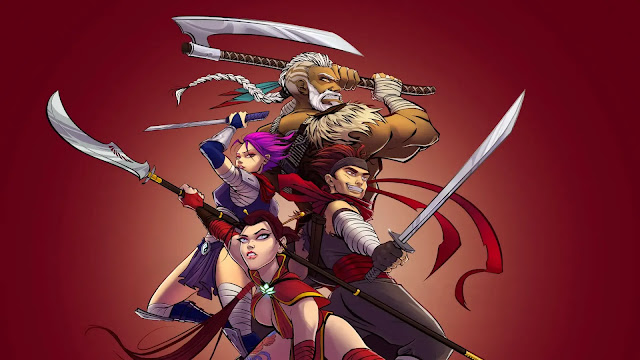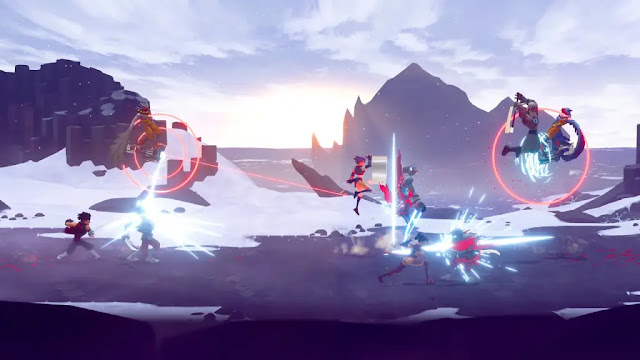Shing! by developer and publisher Mass Creation—Sony PlayStation 4 review written by Nick with a copy provided by the publisher.
Estimated reading time: 6 minutes
Shing! manages to strike a unique balance between classic and modern at the same time. This feels like the type of game that would have felt right at home in the arcades I grew up in, but with plenty of humor and visual flair to back up a unique control scheme.
There are several things about Shing! that stand out, but the control scheme is going to be the primary point of discussion for people, for better and for worse, so we’ll lead off with that. For me, the control scheme worked, if it was not always ideal. So what’s so unique about it? Well, your attacks are done by manipulating the right control stick, giving Shing! an almost twin-stick shooter vibe in what is clearly a brawling beat-‘em-up title.
Without a doubt, this is the most controversial thing about Shing! At first, it was really odd for me. I grew up hammering away on some combination of punch or kick buttons over the years while playing these games, but I found myself barely using the buttons at all in Shing! There are still some things tied to them, such as a clear-out style kick attack, or the ability to short-range dash forward or to use block (though pulling down on the right stick also performs a block). Instead of combos being formed off of hitting punch and kick buttons in specific sequences, they’re pulled off by flicking the right stick in different directions. Tap to the right repeatedly and you’ll poke an enemy with your weapon. Pull the stick upward and you’ll uppercut your opponent into the air where a series of different angles and semi-circular motions will string together a variety of different attacks. When these attacks work the way you’d like, they are gloriously flashy (and often gory) and a lot of fun to look at.
The counter to this however, is that the system can lack precision the way a simple button press does. It also uses my thumb a bit differently than I am used to. Maybe it is just years of muscle memory, but my right thumb did somewhat rebel against this particular control mechanic, and there were times I just wanted to be using face buttons. My left thumb is used to holding the stick in a direction as needed to garner movement, and my right has been trained to do quick button presses or to hold down the right stick for things like direction aim n twin-stick shooters or moving my sights in a shooting game. The rapid movements definitely took getting used to. By the end of the game I felt pretty good about it, but there was definitely a middle point where I found myself wishing I could just mash the circle button for a while instead. Maybe I’m just getting old, but my right thumb was definitely feeling it after long bouts of playing.
Like most brawlers, things can get pretty dicey when you get surrounded by multiple characters on either side – and it only gets more complicated if they have ranged attacks or barriers and such. It was in these frantic moments that the right stick’s lack of precisions frustrated me the most – but I will admit that when I pulled off a series of spectacular, fluid slices that left my demonic enemy split in half on the ground in a bloody heap? It was undeniably satisfying. All four ninjas have different styles of attack, ranging from slow and powerful, to longer reach to shorter range but quicker and everything in between. It sort of reminds me of the old Teenage Mutant Ninja Turtle games in that sense, especially since there are four here. In single player mode, you can jump back and forth between your four ninjas by making use of their hot-mapped slots on the d-pad, bringing in fresh health or the ability to recover a fallen ally. That being said? This game is much more fun with two players, and often makes crowd control (especially during boss battles) a lot more manageable.
There are little things like power-ups you can pick up along the way to give you a boost, and there are four levels of difficulty you can choose from as well. Most of the content is of the beat-‘em-up variety, but there is some light puzzling in places and detours to fill in the narrative gaps as well. The story itself is nothing all that spectacular, but it’s handled in a humorous way that never takes itself seriously and I was completely down with that. The four characters get plenty of voicework, which is a bonus as I found them pretty entertaining to listen to, and the music is well-done and matches the peppy gameplay pace rather nicely. The blocky art style generally looks nice, focusing on vivid colors and smooth animations over details or lots of background movement. This is primarily made me think of older arcade games – it’s not retro in technical execution, but the style certainly gave me that impression. The cutscenes are more detailed, with a slick anime style that I enjoyed.
Another way in which Shing! reminds of classic brawlers is less flattering, and it is the high degree of repetition. It would probably be better if the same enemy types / skins weren’t reused so many times, and the devs tried to vary things up with small challenges and such along the way. I will say however, the boss designs tend to be pretty creative. Instead of just hacking and slashing to a set pattern to be memorized, there are elements of puzzle solving frequently sprinkled into those encounters that make them stand out from the otherwise continuous enemy grind.
There are some strange technical freezes that occur with Shing! as well that I have to call out. On three different occasions the game just froze up - twice after completing mid-level challenge stages, including the first one in the game. Thankfully Shing! has numerous checkpoints and saves throughout, so I never lost much progress, but it was annoying all the same.
Summary
I really enjoyed the sense of humor that Shing! provided, wrapped up in an enjoyable presentation manages to feel fresh in a genre that is seldom innovated in. The biggest innovation however, is the use of the right control stick instead of pressing face buttons. Generally speaking, it works well but does bog down when there are too many enemies on the screen at once or during extended play sessions. It is a cool idea that will no doubt receive mixed reviews, but everything else around Shing! is good enough to warrant a look for those who are fans of the genre.
Score: 7.25 / 10

















0 comments:
Post a Comment